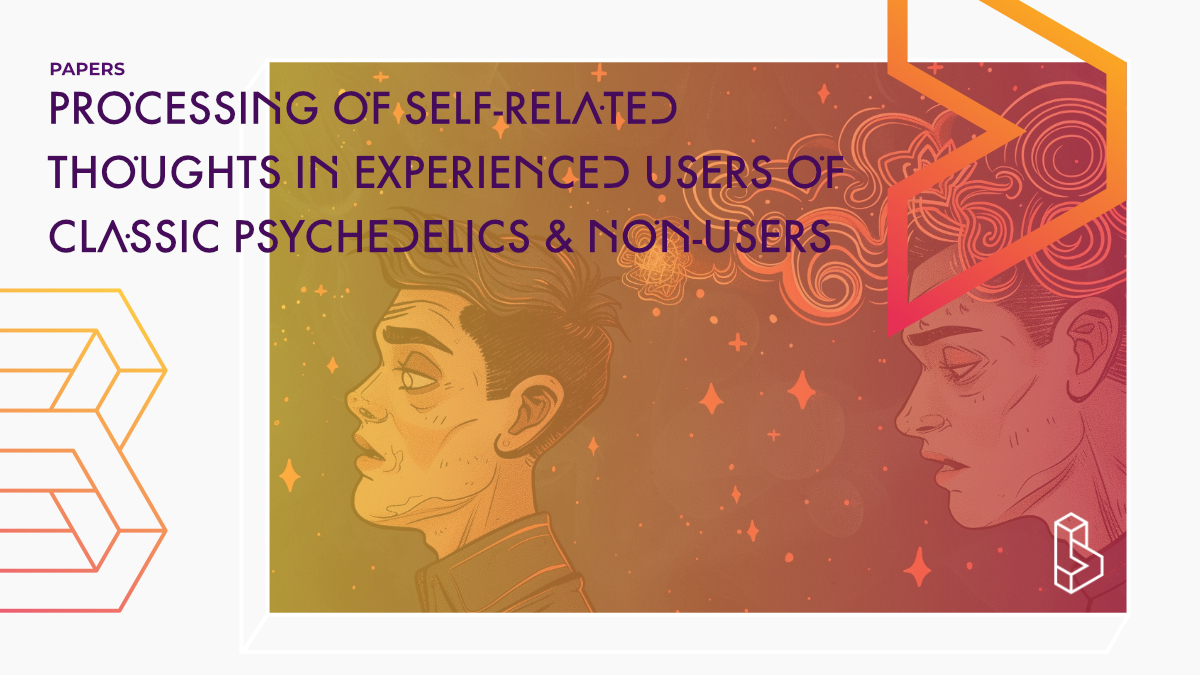This comparative study (dataset I: n=70, II: n=38) explores differences between naturalistic psychedelics users and non-users during the processing of self-related thoughts, using behavioural testing combined with EEG and source localization. Results from Dataset I suggest weaker increases in alpha and beta power in psychedelics users, primarily in brain regions linked to processing self-related information and memory. However, Dataset II did not replicate these effects, possibly due to sample size and spatial resolution limitations.
Abstract of Processing of self-related thoughts in experienced users of classic psychedelics and non-users
“Psychedelics have gained increasing interest in scientific research due to their ability to induce profound alterations in perception, emotional processing and self-consciousness. However, the research regarding the short- and long-term impact of using psychedelics in non-controlled, naturalistic contexts remains limited. Here we aim to fill this gap and explore differences between naturalistic psychedelics users and non-users during processing of self-related thoughts, using behavioural testing combined with electroencephalography (EEG) with source localisation. To ensure robustness of our results, we included two datasets collected at two different laboratories. The results from Dataset I (N = 70) suggest that during self-related thoughts psychedelics users exhibit weaker increases in alpha and beta power in comparison to non-users, primarily in brain regions linked to processing of self-related information and memory. However, analysis of Dataset II (N = 38) did not replicate between-group effects, possibly due to the smaller sample size and spatial resolution limitations. While non-replicability restricts interpretation of our findings, this study contributes to understanding the relationship between the use of psychedelics, self-related thoughts, and well-being, which is crucial for assessing mental health impact of psychedelic substances.”
Authors: Anastasia Ruban, Mikołaj Magnuski, Justyna Hobot, Paweł Orlowski, Aleksandra Kołodziej, Michał Bola & Aneta Brzezicka
Summary of Processing of self-related thoughts in experienced users of classic psychedelics and non-users: a source localisation EEG study
We covered the pre-print in February 2024, the peer-reviewed article was published in November 2024.
Introduction
Psychedelics are psychoactive compounds that have the potential to profoundly alter the state of consciousness. They impact perception, emotional states, and may lead to experiencing visions, dread, bliss, awe, and feelings of self-disintegration. Initial evidence suggests that psychedelics use in controlled, supervised environments, in both clinical and healthy population samples, is associated with long-term improvements in psychological well-being. Specifically, participants suffering from depression, anxiety or substance use disorders show symptom reduction, while healthy individuals exhibit increased well-being and life satisfaction. To address the gap in knowledge about the psychological and physiological functioning of naturalistic psychedelics users, we investigated how the neurophysiological mechanisms associated with the processing of self-related thoughts differ between naturalistic psychedelics users and non-users.
Psychedelics induce changes in self-consciousness that may counteract rumination, a maladaptive form of self-related thoughts that is closely tied to mental health conditions. Psychedelics use may contribute to psychological resilience by shifting self-consciousness from maladaptive to adaptive forms. In this study, we focused on the default mode network (DMN), a large-scale functional brain network engaged in mind-wandering, mental time travel and processing of self-related thoughts, including rumination. Psilocybin decreased the current source density of neuronal oscillations at 1.5 – 20 Hz within a neural network comprising the anterior cingulate cortex. DMN activity is associated with maladaptive forms of self-consciousness, including rumination, and is correlated with different EEG bands, including theta, delta, alpha and beta. In the present study, we explored psychological and electrophysiological differences by induction of self-related thoughts in psychedelics users and psychedelic-naive individuals. We focused on alpha and beta frequency bands in the context of DMN activity and its link to self-related thought.
Find this paper
https://doi.org/10.1016/j.pnpbp.2024.111196
Open Access | Google Scholar | Backup | 🕊
Cite this paper (APA)
Ruban, A., Magnuski, M., Hobot, J., Orłowski, P., Kołodziej, A., Bola, M., & Brzezicka, A. (2024). Processing of self-related thoughts in experienced users of classic psychedelics: A source localisation EEG study. Progress in Neuro-Psychopharmacology and Biological Psychiatry, 111196.
Study details
Participants
108
Humans

